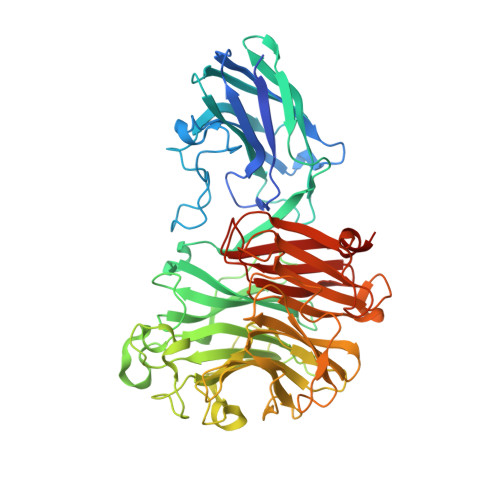Gut bacteria responding to dietary change encode sialidases that exhibit preference for red meat-associated carbohydrates.
Zaramela, L.S., Martino, C., Alisson-Silva, F., Rees, S.D., Diaz, S.L., Chuzel, L., Ganatra, M.B., Taron, C.H., Secrest, P., Zuniga, C., Huang, J., Siegel, D., Chang, G., Varki, A., Zengler, K.(2019) Nat Microbiol 4: 2082-2089
- PubMed: 31548686
- DOI: https://doi.org/10.1038/s41564-019-0564-9
- Primary Citation of Related Structures:
6MNJ, 6MRV, 6MRX, 6MYV - PubMed Abstract:
Dietary habits have been associated with alterations of the human gut resident microorganisms contributing to obesity, diabetes and cancer 1 . In Western diets, red meat is a frequently eaten food 2 , but long-term consumption has been associated with increased risk of disease 3,4 . Red meat is enriched in N-glycolylneuraminic acid (Neu5Gc) that cannot be synthesized by humans 5 . However, consumption can cause Neu5Gc incorporation into cell surface glycans 6 , especially in carcinomas 4,7 . As a consequence, an inflammatory response is triggered when Neu5Gc-containing glycans encounter circulating anti-Neu5Gc antibodies 8,9 . Although bacteria can use free sialic acids as a nutrient source 10-12 , it is currently unknown if gut microorganisms contribute to releasing Neu5Gc from food. We found that a Neu5Gc-rich diet induces changes in the gut microbiota, with Bacteroidales and Clostridiales responding the most. Genome assembling of mouse and human shotgun metagenomic sequencing identified bacterial sialidases with previously unobserved substrate preference for Neu5Gc-containing glycans. X-ray crystallography revealed key amino acids potentially contributing to substrate preference. Additionally, we verified that mouse and human sialidases were able to release Neu5Gc from red meat. The release of Neu5Gc from red meat using bacterial sialidases could reduce the risk of inflammatory diseases associated with red meat consumption, including colorectal cancer 4 and atherosclerosis 13 .
- Department of Pediatrics, University of California, San Diego, CA, USA.
Organizational Affiliation:

















